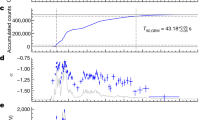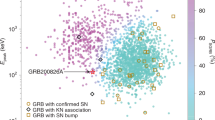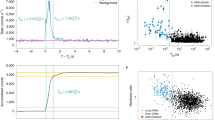Abstract
Two short (< 2 s) γ-ray bursts (GRBs) have recently been localized1,2,3,4 and fading afterglow counterparts detected2,3,4. The combination of these two results left unclear the nature of the host galaxies of the bursts, because one was a star-forming dwarf, while the other was probably an elliptical galaxy. Here we report the X-ray localization of a short burst (GRB 050724) with unusual γ-ray and X-ray properties. The X-ray afterglow lies off the centre of an elliptical galaxy at a redshift of z = 0.258 (ref. 5), coincident with the position determined by ground-based optical and radio observations6,7,8. The low level of star formation typical for elliptical galaxies makes it unlikely that the burst originated in a supernova explosion. A supernova origin was also ruled out for GRB 050709 (refs 3, 31), even though that burst took place in a galaxy with current star formation. The isotropic energy for the short bursts is 2–3 orders of magnitude lower than that for the long bursts. Our results therefore suggest that an alternative source of bursts—the coalescence of binary systems of neutron stars or a neutron star-black hole pair—are the progenitors of short bursts.
This is a preview of subscription content, access via your institution
Access options
Subscribe to this journal
Receive 51 print issues and online access
$199.00 per year
only $3.90 per issue
Buy this article
- Purchase on Springer Link
- Instant access to full article PDF
Prices may be subject to local taxes which are calculated during checkout



Similar content being viewed by others
References
Gehrels, N. et al. A short γ-ray burst apparently associated with an elliptical galaxy at redshift z = 0.225. Nature 437, 851–854 (2005)
Villasenor, J. S. et al. Discovery of the short γ-ray burst GRB 050709. Nature 437, 855–858 (2005)
Fox, D. B. et al. The afterglow of GRB 050709 and the nature of short-hard γ-ray bursts. Nature 437, 845–850 (2005)
Covino, S. et al. Optical emission from GRB 050709: a short/hard GRB in a star-forming galaxy. Astron. Astrophys (submitted)
Prochaska, J. X. et al. GRB 050724: Secure host redshift from Keck. GRB Circ. Netw. 3700 (2005)
Krimm, H. et al. GRB050724: Refined analysis of the Swift-BAT possible short burst. GCN Circ. 3667 (2005)
Berger, E. et al. The afterglow and elliptical host galaxy of the short γ-ray burst GRB 050724. Nature doi:10.1038/nature04238 (this issue)
Burrows, D. N. et al. GRB 050724: Chandra observations of the X-ray afterglow. GCN Circ. 3697 (2005)
Gehrels, N. et al. The Swift γ ray burst mission. Astrophys. J. 611, 1005–1020 (2004)
Kouveliotou, C. et al. Identification of two classes of γ-ray bursts. Astrophys. J. 413, L101–L104 (1993)
Boer, M. et al. GRB 050709: refined spectral and temporal properties. GCN Circ. 3653 (2005)
Connaughton, V. BATSE observations of γ-ray burst tails. Astrophys. J. 567, 1028–1036 (2002)
Lazzati, D., Ramirez-Ruiz, E. & Ghisellini, G. Possible detection of hard X-ray afterglows of short γ-ray bursts. Astron. Astrophys. 379, L39–L43 (2001)
Covino, S. et al. GRB 050724: a short burst detected by Swift. GCN Circ. 3665 (2005)
Antonelli, L. A. et al. GRB 050724: Swift XRT refined position. GCN Circ. 3678 (2005)
Gal-Yam, A. et al. GRB 050724: Optical variability in a nearby galaxy. GCN Circ. 3681 (2005)
D'Avanzo, P. et al. GRB050724: VLT observations of the variable source. GCN Circ. 3690 (2005)
Bloom, J. S. et al. GRB 050724: Optical imaging/astrometry. GCN Circ. 3672 (2005)
Kochanek, C. S. et al. The K-band galaxy luminosity function. Astrophys. J. 560, 566–579 (2001)
Castro-Tirado, A. J. et al. GRB 050724: Optical and near-IR observations. GCN Circ. 3673 (2005)
Le Floc'h, E. et al. Are the hosts of γ-ray bursts sub-luminous and blue galaxies? Astron. Astrophys 400, 499–510 (2003)
Woosley, S. E. γ-ray bursts from stellar mass accretion disks around black holes. Astrophys. J. 405, 273–277 (1993)
Hurley, K. et al. An exceptionally bright flare from SGR 1806–20 and the origin of short duration γ-ray bursts. Nature 434, 1098–1103 (2005)
Palmer, D. M. et al. A giant γ-ray flare from the magnetar SGR 1806–20. Nature 434, 1107–1109 (2005)
Frail, D. A. et al. Beaming in γ-ray bursts: Evidence for a standard energy reservoir. Astrophys. J. 562, L55–L58 (2001)
Kumar, P. & Panaitescu, A. Afterglow emission from naked γ-ray bursts. Astrophys. J. 541, L51–L54 (2000)
Burrows, D. N. et al. Bright X-ray flares in γ-ray burst afterglows. Science 309, 1833–1855 (2005)
Rosswog, S., Ramirez-Ruiz, E., & Davies, M. B. High-resolution calculations of merging neutron stars—III. γ-ray bursts. Mon. Not. R. Astron. Soc. 345, 1077–1090 (2003)
Lee, W. H., Ramirez-Ruiz, E. & Granot, J. A compact binary merger model for the short, hard GRB 050509b. Preprint at http://arXiv.org/astro-ph0504104 (2005).
Davies, M. B., Levan, A. & King, A. The ultimate outcome of black hole—neutron star mergers. Mon. Not. R. Astron. Soc. 356, 54–58 (2005)
Hjorth, J. et al. The optical afterglow of the short γ-ray burst GRB 050709. Nature 437, 859–861 (2005)
Acknowledgements
We acknowledge support from ASI, NASA and PPARC, and acknowledge benefits from collaboration within the EU FP5 Research Training Network ‘γ-Ray Bursts: An Enigma and a Tool’.
Author information
Authors and Affiliations
Corresponding author
Ethics declarations
Competing interests
Reprints and permissions information is available at npg.nature.com/reprintsandpermissions. The authors declare no competing financial interests.
Rights and permissions
About this article
Cite this article
Barthelmy, S., Chincarini, G., Burrows, D. et al. An origin for short γ-ray bursts unassociated with current star formation. Nature 438, 994–996 (2005). https://doi.org/10.1038/nature04392
Received:
Accepted:
Published:
Issue Date:
DOI: https://doi.org/10.1038/nature04392
This article is cited by
-
The case for a minute-long merger-driven gamma-ray burst from fast-cooling synchrotron emission
Nature Astronomy (2022)
-
Detection of short high-energy transients in the local universe with SVOM/ECLAIRs
Astrophysics and Space Science (2020)
-
Scientific prospects for spectroscopy of the gamma-ray burst prompt emission with SVOM
Experimental Astronomy (2017)
-
Self-organized criticality in X-ray flares of gamma-ray-burst afterglows
Nature Physics (2013)
-
Gamma-ray bursts in the swift-Fermi era
Frontiers of Physics (2013)
Comments
By submitting a comment you agree to abide by our Terms and Community Guidelines. If you find something abusive or that does not comply with our terms or guidelines please flag it as inappropriate.



